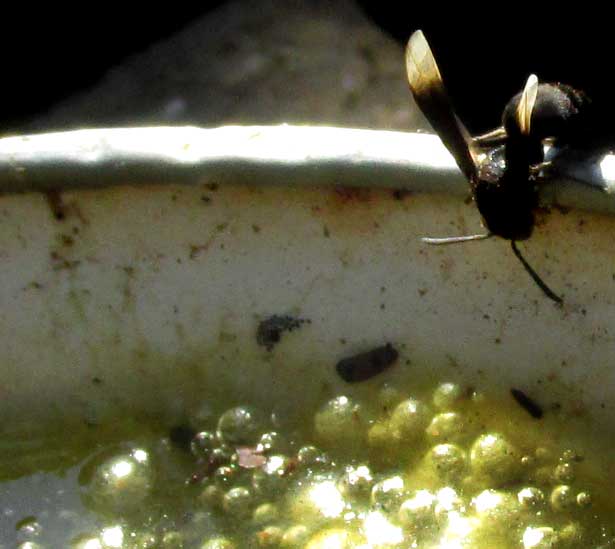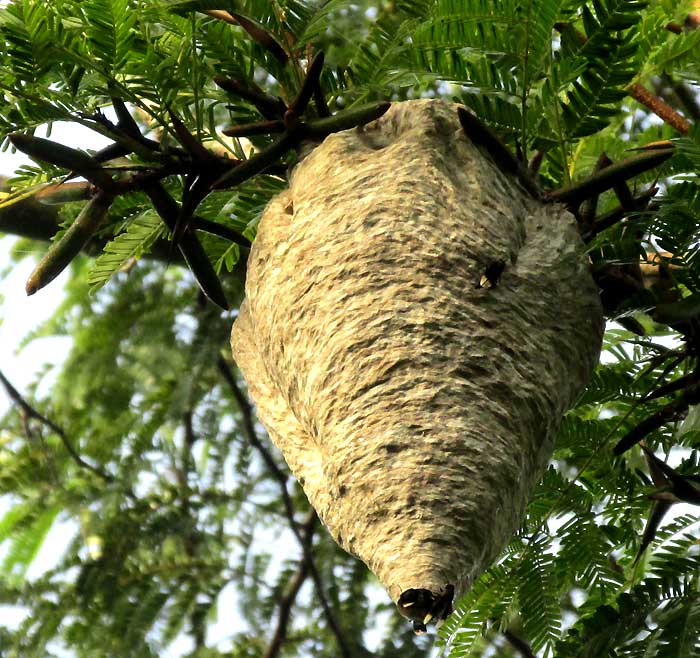Excerpts from Jim Conrad's
Naturalist Newsletter
Entry issued on December 10, 2019, from the forest just west of Tepakán; elev. ~9m (~30 ft), N21.053°, W89.052°; north-central Yucatán state, MÉXICO
"WHITE-WINGED WASP"
For a couple of months, on the outside kitchen's concrete table, I've kept a junk skillet filled with rainwater. I've enjoyed seeing the almost-microscopic organisms that somehow found their way into the water. An algal mat floats atop the water, kept afloat by bubbles of oxygen the photosynthesizing algae produce. Even before the rainy season ended, a certain kind of wasp began visiting the skillet, much of the day one after another presumably drinking water, but also maybe foraging on algae growing up the skillet's sides, as shown below.

So many wasp species occur in the Yucatan that generally I don't try to identify them. However, you can see that this one is black with very conspicuous white wing tips. Also, one day while clearing a trail through the rancho's regenerating forest I saw the same species working on the paper nest shown below:

Notice that this paper nest is yet another that habitually is placed among the feathery leaves and formidable thorns of our common Bull-horn Acacia, Acacia collinsii. The nest is protected not only by its stinging workers, but by the tree's big spines.
Now having an unusual looking wasp that definitely constructs paper nests, maybe I could identify it. After scanning hundreds of Google image thumbnails, finally I found the species identified at the inaturalist.org website, under the heading "Abejas y véspídos de la Península de Yucatán." It's PARACHARTERGUS APICALIS. With the binomial, I found plenty of interesting information.
For, Parachartergus apicalis, sometimes in English called White-winged Wasp, is widely distributed throughout the American tropics, and studies have been conducted on it. For example, there's one by S. O'Donnell and James Hunt, published in Insectes Sociaux 2013 DOI:10.1007/s00040-013-0302-x, entitled "Group hunting by workers of two Neotropical swarm-founding paper wasps, Parachartergus apicalis and Agelaia sp." Here it's reported that several worker wasps of our species simultaneously attack live caterpillar prey -- even caterpillars much larger than they, larger than 88mm (3.5inches).
Elsewhere I read that workers of Parachartergus apicalis have been seen tending plant-sap-feeding insects, such as treehoppers. In a classic mutualistic relationship, the wasp attacks ants endangering treehopper nymphs who produce sweet honeydew the wasps are glad to have. Each wasp is loyal to one group of treehopoper nymphs, and leaves them for less than ten minutes at a time.
In the natural world, our wasp has such a reputation for its stings that at least two moth species have evolved to look like them, to "mimick" the wasp's appearance.
Entry issued on December 14, 2019, from the forest just west of Tepakán; elev. ~9m (~30 ft), N21.053°, W89.052°; north-central Yucatán state, MÉXICO
THE FINISHED NEST
Above, our wasp's nest was only half finished. Now it's complete, shown below:
